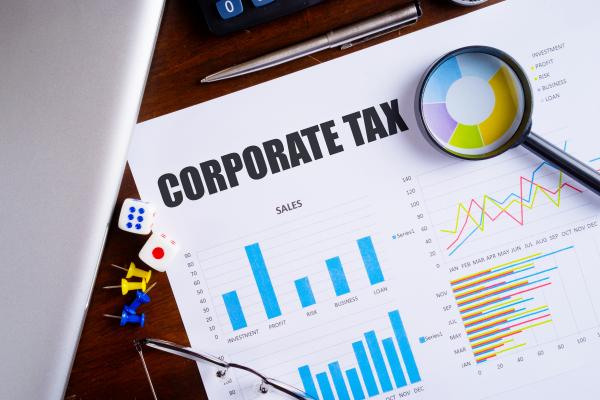
CT rate changes and straddling periods
1 April 2023 brought with it a brand new set of corporation tax rates and rules. This article looks at the implications of apportioning profits where a company has an accounting period that spans this date, including where it has realised gains.
Background
As a quick refresher, from 1 April 2023, the corporation tax rate a company pays in any accounting period depends on its ‘augmented profits’ (broadly taxable profits plus exempt non-group dividends):
- At or below the ‘lower limit’ of £50,000 – small profits rate of 19%
- Above the ‘upper limit’ of £250,000 – main rate of 25%
- Between £50,000 and £250,000 – main rate of 25% less marginal relief
Where an accounting period spans 1 April 2023, it has to be split into two notional accounting periods – one ending on 31 March 2023 and the other starting on 1 April 2023.
For example, a company with a 31 December accounting date will have two notional accounting periods in the year ending 31 December 2023:
- A first notional period running from 1 January 2023 to 31 March 2023.
- A second notional period running from 1 April 2023 to 31 December 2023.
Only the profits of the second notional accounting period (i.e. the one starting on 1 April) fall within the new rates. The profits of the first notional accounting period (ending 31 March) will be taxed at the previous corporation tax rate of 19%.
What about gains?
To calculate the profits for each notional period, the total taxable profits for the full year need to be time apportioned.
However, what happens when a company realises a chargeable gain during a period which straddles 1 April 2023? Do we apportion the gain on a time basis between the two notional periods in the same way as other profits? Or do we allocate it in full to the notional period in which the disposal occurred? The answer could have a material impact on the tax payable on the gain.
HMRC have now confirmed to the ATT that total profits (which includes any chargeable gains) for straddling accounting periods have to be time apportioned between the two notional periods falling pre-1 April 2023 and from 1 April 2023. There is no separate allocation of any chargeable gains to those periods by reference to when the gains are realised.
This flows from s4 CTA 2010, which states that the profits of a company’s accounting period on which corporation tax is chargeable, are the company’s total taxable profits which are made up of:
- The amount on which the company is chargeable in respect of income after deduction of all reliefs, and
- Chargeable gains of the accounting period after any relevant reliefs (i.e. net of allowable capital losses of the period and brought forward capital losses).
Where amounts have to be apportioned between different periods, s1172(1) CTA 2010 requires this to be done on a time basis. s1172(2) does however provide for a different basis where specific provisions override that. For example, the commencement provision for the introduction of the loss reform legislation in 2017 provided that, where apportionment on a time basis produced a result that was unjust or unreasonable, an alternative just and reasonable basis could be used instead. However, there is no such alternative basis provided for in the commencement provisions for the new CT rates from 2023 in para 34(2) Sch 1 FA 2021. As a result, we are back to time apportionment of all profits, including gains.
For example, a company has taxable trading profits for the year ending 31 December 2023 of £1m and disposed of a chargeable asset in January 2023, realising a gain of £200,000. The company will have two notional accounting periods for 2023:
- A first notional period running from 1 January 2023 to 31 March 2023.
- A second notional period running from 1 April 2023 to 31 December 2023.
The total taxable profits of £1.2m (comprising the trading profits and taxable gain) will need to be time apportioned between the two periods, as follows:
- First notional period = £1.2m x (90/365) = £295,890 which is taxable at 19%
- Second notional period = £1.2m x (275/365) = £904,110 which is taxable at 25%
Watch the thresholds
As outlined above, the commencement provisions provide for accounting periods straddling 1 April 2023 to be treated as two different notional accounting periods with profits (including gains) time apportioned between them.
In the previous example, this apportionment was necessary to ensure that the new 25% main rate was correctly applied from 1 April 2023. Smaller companies will also need to check whether their apportioned profits for the second notional period are low enough to qualify for the small profits rate or marginal relief in that period.
For these purposes, as the second notional period will be less than 12 months long, you need to reduce the upper and lower limits accordingly
For example, a company with a 31 December 2023 year-end will have two notional accounting periods:
- 1 January 2023 to 31 March 2023
- 1 April 2023 to 31 December 2023
The profits apportioned to the first period are taxed at 19%.
The profits apportioned to the second period need to be compared to the reduced lower limit of £37,671 (275/365 x £50,000) and reduced upper limit of £187,841 (275/365 x £250,000) to see if the small profits rate or marginal relief apply. You may also need to reduce these limits further if there are any associated companies in the second notional period.
There is more information on the interaction of straddling periods, thresholds and associated companies in HMRC’s guidance at CTM03955.















